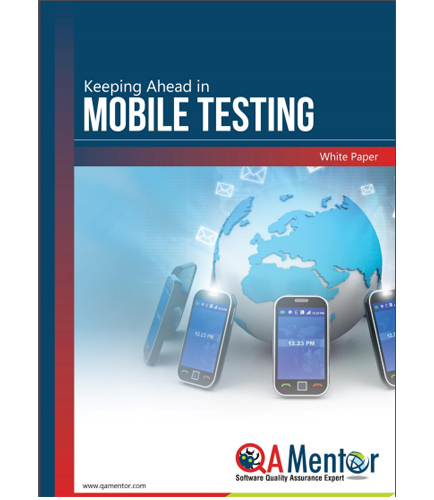
PROCESSING. PLEASE WAIT...


White Paper: QA Mentor
Challenges faced in mobile application testing must be addressed in order to expedite successful market releases.
The fast pace of the mobile market means a lot of quick mobile testing just to keep up. Development and testing of mobile applications is inherently more complicated than it is with PCs. Usage of multiple signals such as Wi-Fi, Bluetooth, etc can interfere with the performance of applications. By far, this is the most significant issue faced by mobile development and testing.
So, how can we counter these mobile testing challenges?
What is the most cost effective way to meet all of the mobile testing challenges by keeping your overhead low? How can you choose the best mobile testing software to help with this?
This whitepaper suggests a combination of mobile testing models to meet the challenges of mobile testing while providing necessary coverage. It also explains about outsourcing mobile testing and other cost effective ways to meet all of the mobile testing challenges.
It will show you how major mobile testing challenges can be overcome by a 3 step testing strategy which involves
Tackling the compatibility issues due to dozens of makes and models.
Crowd sourced testing service providers.
Emulators to fill in the holes to meet the necessary coverage requirements.
By: L&T Infotech
Every organization should have well-organized and effective testing strategies in order to increase test efficiency and deliver high quality software. Test data is one of the most important factors in overall testing life cycle. Scenario-specific, realistic, right-sized, masked test data created in test environments ensures the following: - Scenario-specific test data availability before test execution increases test efficiency/quality and reduces overall testing cycle time. - Realistic test data in lower test regions reduces production defect leakages. - Right-sized test data in test environments reduces space utilization and increases the response time. - Masked test data ensures security compliance
By: QA Mentor
Why is it significant to properly manage test environments? How should we do it? What are the best practices and strategies to use test environment management tools and services? Test environment management strategy involves guiding and managing the test environment hardware, software, databases, applications, and test data. Slowed testing and inconsistent results are caused by poorly managed environments while problematic, testing issues are caused by inadequate test data management. Most test environment issues can be boiled down by proper test environment management. In order to manage test environment efficiently, the following are necessary: A dedicated Test Environment Management (TEM) team. Defining the team terminology and sticking to it. Creating an easily accessible knowledge base. Defining the test environment strategy. Improving efficiency and productivity in testing. Test management tools that can assist the TEM. Download this whitepaper to build a stronger, better managed test environment which brings a reduction in production issues, increased productivity, and higher customer satisfaction rates.


 2025 All Rights Reserved | by: www.ciowhitepapersreview.com
2025 All Rights Reserved | by: www.ciowhitepapersreview.com